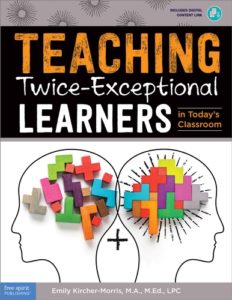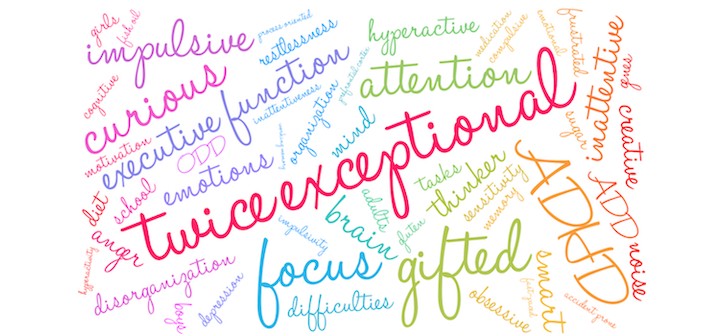Help Twice-Exceptional (2e) Learners Flourish
By Emily Kircher-Morris

My executive function skills were terrible, I was fidgety and impulsive, and I managed to do well in my classes despite what appeared to be poor motivation and effort.
Living at both ends of the bell curve
We didn’t use the term back then, but I was “twice-exceptional.” Twice-exceptional (or 2e) is a term that indicates someone is living life at both ends of the bell curve. 2e learners have advanced cognitive abilities (generally measured by an intelligence test) and a diagnostic disability, such as ADHD, autism, dyslexia, or dysgraphia. Both of these traits co-exist, causing a lot of confusion for parents, teachers, and students alike.
Sometimes a person’s cognitive ability can mask their struggles. This means that teachers see a student who is very bright, but they aren’t able to see the difficulties with focus, social communication, or academics as clearly. Twice-exceptional students are often diagnosed with their disability much later than their same-age peers due to this obfuscation.
Eventually, if these students aren’t accurately labeled with a diagnosis, they may be labeled something else: lazy, unmotivated, or slow. These students also struggle to see their own strengths and obstacles clearly, recognizing that they understand advanced concepts but often don’t perform as well in school as their peers.
When disability masks intelligence
The reverse of this can also be true: a twice-exceptional student’s disability may rise to the surface, hiding their intelligence. If the student is recognized as a behavior problem or has trouble with emotional regulation, their cognitive ability might go unnoticed. These students go unchallenged academically and are unable to reach their potential.
Twice-exceptional students may be more likely to be identified in today’s classrooms due to the shift in identification processes for gifted education programs. As schools have moved to using universal screening procedures, more 2e students are being caught who may not have been identified for services based solely on grades or teacher recommendations.
(Universal screening is a process where all students in a grade level are screened for cognitive ability. Initially it was used as a tool to improve identification of culturally and linguistically diverse learners. However, an added benefit is that is has allowed schools to recognize twice-exceptional learners, too.)
What twice-exceptional learners need
What types of supports do twice-exceptional learners need to be successful in the classroom? Each student has different needs, and the range of students who are 2e is broad and diverse. Creating a neurodiversity affirming classroom is a key component of supporting twice-exceptional learners.
Four characteristics of neurodiversity affirming schools are that they value differences, offer strengths-based interventions, have a collaborative staff, and allow autonomy.
Valuing Differences – Neurodivergent students often spend a lot of time hiding their differences to fit in. Autistic students may suppress the urge to stim because they will be judged by their teachers (stimming is typically a tool for emotional regulation used by autistic people); ADHD students may not share their divergent thinking because others will think they are weird; gifted kids may try to hide their intelligence.
Pressure is placed on neurodivergent kids to socialize in the “right” ways, even if it isn’t what is comfortable or preferable to that student. In order to be neurodiversity affirming, we have to fight against the stigma that comes along with people being a little different. We have to teach our neurotypical students to understand and accept those who think and act differently than themselves.
Strengths-Based – There are a variety of reasons why strengths-based instruction and accommodations are the key to success for neurodivergent students, but the easiest way to explain it is to understand that nobody enjoys doing something that they are bad at doing, especially if they have to do it over and over again.
For example, if we want to support a child in building emotional regulation skills, there is value to having them practice this skill within the context of playing (and possibly losing?) a strategy game. Or tweaking a project or assignment for an autistic student to align with their favorite topic of interest helps them engage.
Monotropism is a characteristic of autism; it means that someone tends to focus on a single topic at a time and to have difficulty transitioning from it. Rather than trying to pull students into our world to help them learn a skill, why not leverage that strength of focus on a topic and build the skill within that context?
The Self-Determination Theory of Motivation describes three main ingredients necessary for someone to feel motivated. One of those ingredients is experiencing a feeling of competence. If we are frequently pulling our neurodivergent students outside of the range of activities where they feel competent, their motivation is going to be weak.
Collaborative Staff – Especially as it relates to twice-exceptional children, a collaborative staff is key. For example, a gifted/dyslexic student might have the cognitive skills to be successful in the gifted education classroom – assuming that there are accommodations that can be made to help them access the curriculum. However, many gifted education teachers don’t have much training in providing accommodations or supporting students with an IEP in their classes.
Additionally, general and special education teachers may not have a lot of experience with supporting the heightened cognitive abilities of 2e learners. Staff may be unfamiliar with the fact that a student may qualify both for gifted and special education services simultaneously. When teachers collaborate and build on each other’s expertise, neurodivergent students are able to be supported in the various environments within the school.
Allows Autonomy – The last characteristic of a neurodiversity affirming school is that it allows autonomy and choice to the students. A sense of autonomy or agency is the second of the three ingredients necessary for a student to feel motivated according to the Self-Determination Theory of Motivation. (The third ingredient is a sense of connection and relatedness.) Some neurodivergent kids might be demand avoidant; providing choice and autonomy can help them to feel a sense of control over their day.
Additionally, giving as much autonomy as possible is a useful tool to help students, neurodivergent or not, learn skills related to self-regulation for learning. This might look like letting students choose in what order to do their work, how they want to show their mastery of a topic, or what topic to study.
Another benefit for neurodivergent and twice-exceptional students is that an environment that encourages autonomy also fosters self-advocacy skills, which are necessary as students who learn and think differently grow up.
Recognition is the first step
The first step to supporting twice-exceptional students is recognizing that they exist and are probably in your classroom. Once we’ve achieved that task, we can start working on creating a neurodiversity-affirming school that allows every student, neurodivergent or not, to reach their potential.




































Yes, so affirming to read this. I have a son, now an adult, who was diagnosed w/ a language processing disorder, but is gifted in math and tech related subjects. Thank goodness his high school was able to accommodate his needs, and the tech college understood what was going on.
In his case, skipping SATs, going to our local community college and then just transferring into a 4 year IT program worked. This is not uncommon with many of the students who go into computer related fields.
My daughter was fortunate to have a teacher who took the time to look at her assessments and screenings with a fine tooth comb. She was even an exception to the 2e definition. At that time (38 years ago), the diagnosis of 2e was rare and not much was known about how to help the 2e child.
She was terrible in the math and sciences, but her language and writing skills were remarkable. She was actually in high school before we could really find a teacher and psychologist to help her find ways to learn material that made sense to them and to her. She always could come up with answers and solve problems, it was just the way she went about it. She has a BA in anthropology from University of Boston and is doing well.